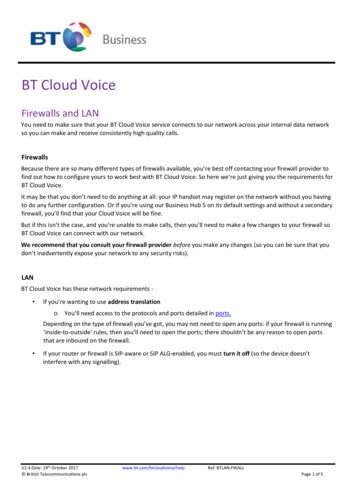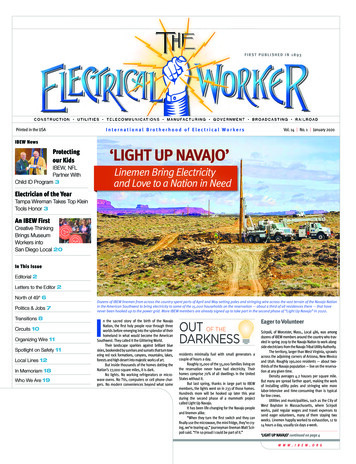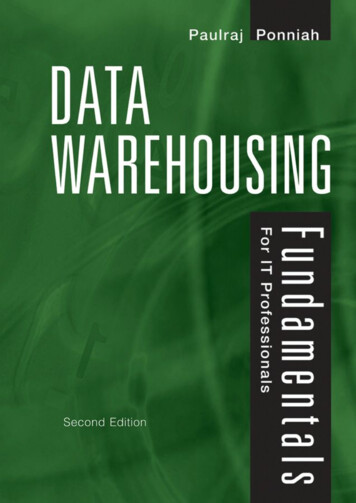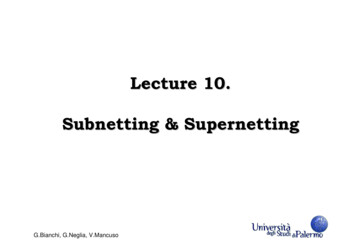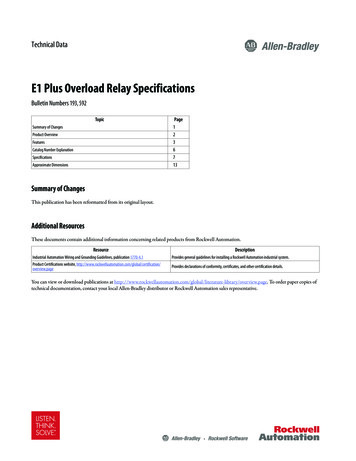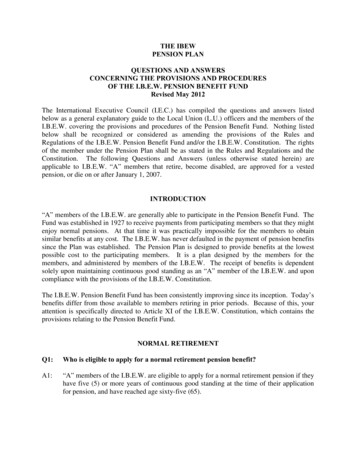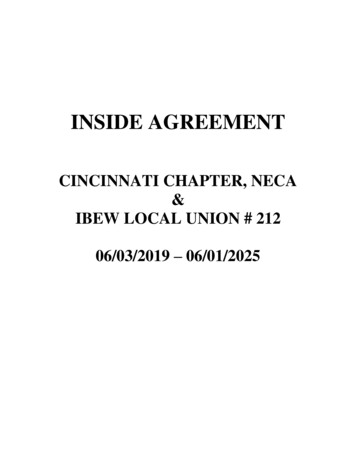
Transcription
FIRST PUBLISHED IN 1893Printed in the USAInternational Brotherhood of Electrical WorkersVol. 14 No. 8 August 2020IBEW NewsOne of Our OwnOur cause isIBEW Widow WinsIowa Senate Primary,Takes on GOP’s Ernst 3Apprenticeships Go Virtualthe cause ofPandemic Prompts Shifts inTraining for New Electricians 12In This IssueEditorials 2human justice,Letters to the Editor 2My IBEW Story 2North of 49 6Circuits 7human rights,Transitions 8Organizing Wire 9In Memoriam 9 & 10Who We Are 11THE IBEW’s2020 PHOTOCONTESTDeadline: Oct. 1See page 5 for detailshuman security.The first page of the IBEW Constitution beginswith a declaration:“Our cause is the cause of human justice, human rights, human security.”It’s a powerful statement of the values thatIBEW leaders and members pledge to uphold whenthey take the oath of membership. And combinedwith the union’s first objective, to organize all workers in the entire electrical industry in the UnitedStates and Canada, the message is unmistakable.BUILDING ASTRONGERIBEW“There is a place in the IBEW for working peopleof every race and gender, every religion and sexualorientation, every background,” said InternationalPresident Lonnie R. Stephenson in launching theimplementation phase of the union’s new diversity,inclusion and equity initiative, “IBEW Strong.”“This diversity and full inclusion effort is aboutmaking sure that the IBEW genuinely represents theinterests of every single worker in our industries,” hesaid. “It’s about ensuring that people entering theworkforce today — members of one of the mostdiverse generations in history — feel that they have aplace in the IBEW.”There’s nothing new about seeking to representthe voiceless and unrepresented. The IBEW has longstood for solidarity, equality and against oppression ofany kind. So, IBEW Strong is a natural outgrowth ofwhat this union has stood for since its beginning, Stephenson said. The IBEW should be a place that welcomes all workers and gives everyone a voice and ashot at a better life for themselves and their families.“We need to include everyone, regardless ofhistory, background, or job classification,” said Boise, Idaho, Local 291 Business Manager Mark Zaleski,who served on the Diversity and Inclusion Committee. “Society is changing, but the thing is, everyoneBUILDING A STRONGER IBEW continued on page 4W W W . I B E W . O R G
2The Electrical Worker August 2020FROM THE OFFICERSEDITORIALSA More Perfect UnionIn this month’s Electrical Worker, I hope you’ll all take the time to read about aninitiative very near and dear to me and an effort critically important to everymember and future member of the IBEW.I’m talking about IBEW Strong, our plan to continue building an IBEWthat is more diverse, more inclusive and better prepared to face the challengesof the future.Since the civil rights movement of the 1960s, Labor has stood with thoseseeking equity and justice, but too often we’ve not taken the concrete steps toensure those basic rights within our own unions.With IBEW Strong, we will strive not just to educate, reach out and diversifyour ranks, but to learn from one another, to empower a new generation of leadersand continue to grow and thrive collectively in a 21st-century economy.This idea isn’t new. All across North America, local unions have been recruitLonnie R. Stephensoning from their entire communities for decades. You’ll read about just a few examInternational Presidentples in the accompanying article. Whether it’s reaching into communities of coloror working to make the trades more welcoming to our sisters or people with preferences or beliefs different from our own, the IBEW is stronger when it reflects the diversity of the communities we liveand work in.Four years ago, at the 2016 International Convention in St. Louis, we celebrated this brotherhood’s 125th birthday, and the delegates to that convention unanimously called on us to make diversity and inclusion a priority.I want to thank the officers and the members of the Diversity and Inclusion Committee we assembled after theconvention for their tireless work in getting us to this stage. A great deal of thought and care has gone into setting IBEWStrong up to be successful.Now, it’s our turn. I want to ask each and every one of you to consider how you can help make the IBEW a moreequitable and inclusive place that reflects the broader diversity of the nations we serve. We’ll have materials andresources for you available through your local unions, but it’s up to each of us to do our part.As I’ve said many times before, joining the IBEW changed everything for me, just as I know it did for so many ofyou. This is our chance to make sure many more people from all walks of life enjoy the same opportunities we did. zResponding to CrisisAs I’ve heard stories of members and locals responding to the COVID-19crisis both on and off the job these last five months, I’ve been filledwith pride for this brotherhood of ours.As secretary-treasurer, there’s no job I take more seriously thanmy responsibility for your pension and health plans. Your health and your retirement security are always at the top of my mind, especially in times of crisis.Over the last 14 years, we’ve grown the IBEW/NECA Family Medical Care Planinto a thriving health care option for locals and employers who choose to participate. The numbers tell an impressive story: We now have more than 100,000 people covered by the plan in all 50 states.Because we’ve chosen to manage our own health care, we’re able to respondmore quickly to events like COVID-19. With our NECA partners, the FMCP has theability to be more agile than large corporate plans to meet the immediate needs of Kenneth W. CooperIBEW participants and their dependents.International Secretary-TreasurerIt’s that flexibility that has allowed us to cover the costs associated withtesting for and treatment of COVID-19 with no deductibles or side charges and toflex to cover telemedicine visits for participants who aren’t able to have an in-person visit with a doctor. The plan’s LiveHealth Online app has been invaluable in getting participants access to a real doctor from the safety of home.But times like these aren’t just for responding to crisis. They’re about planning for the future. And that’s anotherplace FMCP can be a real tool for our local unions. Its benefits are usually equal to or better than company-offeredplans, and as employers look to save costs, we can often provide the same health benefits at better rates because wedon’t spend a dime on advertising or shareholder profits.The FMCP has proven to be a terrific tool for retaining members and for bringing in new ones, too. This year, six newindividual bargaining units have signed on, bringing us to a total of 243, including at seven Fortune 500 companies.For any local union leader who hears talk of cutting health benefits in response to this crisis, your first call shouldbe to FMCP to see if there’s a better way. Or start online at nifmcp.com.Our goal, as always, is to give our local unions and our members the tools to take care of our families. That’s evenmore important in turbulent times like these, and I promise we’re on the job, working harder than ever.Stay strong and stay safe, brothers and sisters, and thank you for the work you do every day. z LETTERSTO THE EDITOR Editor’s note:Honolulu Local 1186 member Bill Schroeder saw a letter in his local newspaper, theHonolulu Star-Advertiser, attacking the cost of union labor during the pandemic andchose to respond. Send your own letters about the important work you and your IBEWsisters and brothers are doing during the COVID-19 crisis to your paper’s “Letter to theEditor” section. It’s a great way to share your IBEW pride in your communities.Trained for SafetyI am a member of IBEW 1186.Our members are highly trained and motivated to perform the work of our trade.We spend as much time in classes as those with a Ph.D., to get our electrical licensesand keep our skills up to date. Any member who does not meet the professional andwork ethic requirements is asked to leave.The current wage and benefits package affords us a good quality of life for ourfamilies and is fair based on the nature of our work.The job of an electrician is to keep buildings from burning down; the National Electrical Code is written by the National Fire Protection Association of America. To performour work, we must learn and adhere to those standards.Anyone who desires “cheap” will receive what they paid for.Bill Schroeder, Local 1186 memberHonoluluWe Want to Hear From You: Send your letters to media@ibew.org or Letters to theEditor, The Electrical Worker, 900 Seventh Street, N.W., Washington, D.C. 20001.From Facebook: Every month the IBEW Facebook page receivesthousands of comments from our dynamic and engaged communityof members and friends.Welcome to the IBEWResponding to “AGL Employees Ratify First Contract, Become Full IBEW Members AmidPandemic” from last month’s Electrical Worker:You’ll never regret joining a union. Stick it out and you’re set for life, from a happy IBEWVerizon retiree.Brian Harrigan, former Local 1451 business manager/presidentYork, Pa.Please visit IBEW.org/COVID-19 for the latest information about the IBEW’s response tothe coronavirus, and keep sending us your stories of everyday IBEW heroes atmedia@ibew.orgNicolas Wakeen, Retired Journeyman WiremanEau Claire, Wis., Local 14“Attention Business Managers and Press SecretariesLocal Lines will return on its normal schedule in October’s Electrical Worker, starting with even-numbered locals and retirees’clubs. Odd-numbered locals will resume on their regular schedule starting in November. Please visit ibew.org/media-center oremail locallines@ibew.org for more information. zShare your story at ibew.org/MyIBEWStory
The Electrical Worker August 2020 3IBEW MEDIAWORLDIn addition to your monthlyissue of The ElectricalWorker, check out thewealth of IBEW-relatedinformation online.Des Moines Local 347 membersstaged a labor drive-by on primaryday June 3 to cheer on pro-unioncandidate Theresa Greenfield,who won the Democratic race tochallenge anti-worker Sen. JoniErnst in November.IBEW Widow Champions Workers inIowa’s U.S. Senate ContestTheresa Greenfield awoke tobright, sunny skies on June 3,1988, roused her lineman husband, packed his lunch and sawhim off to work.It was a typical weekday for theyoung couple. They had a 13-month-oldson and another on the way. They wereplanning to buy a house and already savingfor retirement, thanks to Rod’s IBEW-wagejob and benefits at Interstate Power Co.She heard a knock at the door thatafternoon, not long before she expectedRod home. Through a window, she sawher priest. A group of her husband’s IBEWbrothers stood somberly a respectful distance behind.“I’m so sorry,” the clergyman said,gently taking her hand. “There’s been anaccident at work. Rod was electrocuted.”She couldn’t make sense of hiswords. “How is he?” she asked. “Wherecan I go see him?”“No, honey,” he said. “He’s died.”ON JUNE 2, 2020, TheresaGreenfield won a four-way primary tobecame Iowa’s Democratic challenger toU.S. Sen. Joni Ernst.It was a day shy of 32 years since herworld collapsed, since the moment shewent from being a stay-at-home mom withfinancial security to a single parent who’dsoon have two babies to raise by herself.But she wasn’t alone. Her IBEW family and other union members embracedher so tightly that she can still feel it today.“They provided comfort andstrength and courage,” Greenfield said ina June 25 interview with The ElectricalWorker. “They stopped by with meals,they watched my kids while I got groceries. They shoveled snow.”She remembers her anxiety thatfirst blizzard without Rod. “I thought, ‘I’vegot two babies. How am I going to dealwith snow?’ I woke to a clatter and unionmembers were shoveling my drivewayand my walk. I didn’t have to shovel allwinter. It brings me to tears.”Critical to her peace of mind, Burnsville, Minn., Local 949 leaders assured her“I wouldn’t be standinghere today, fightingfor this seat, fightingfor you, if it were notfor Social Securityand hard-earnedunion benefits.”– Theresa Greenfieldshe’d receive Rod’s union benefits, alongwith Social Security survivor benefits.Step by step she rebuilt her life —she returned to school, got a job, happilyremarried, raised four children, andbecame president of a small family-ownedreal estate business.It pains her to see families todaybankrupted by medical bills, desperateworkers a paycheck away from homelessness, farmers in her state buried beneaththe weight of record debt, and so manyother Americans in crisis.She is running for office to fight forthem, for the kind of opportunities andsupport system that saved her.“I wouldn’t be standing here today,fighting for this seat, fighting for you, if itwere not for Social Security and hardearned union benefits,” she said on thestump during the primary campaign.“I was able to go back to college. Igot my very first job as a single mom, for 8 an hour, and I couldn’t have beenprouder. I got my dignity back. Absolutelyeverybody in America wants the dignity ofproviding for their families.”HER MESSAGE is resonatingwith Iowans. She made national news inmid-June when a Des Moines Register pollput her three points ahead of Ernst, afirst-term Republican.Greenfield was thrilled, but notentirely surprised. “I grew up rural, and Iknow that people feel she’s not representing them,” she said. “They’re feelingleft behind.”Patrick Wells, business manager ofDes Moines Local 347, said Greenfield ismaking a sincere connection with voters.“She holds true Iowa values,” hesaid. “No hidden agendas, no corporatePACs controlling her. She is in it for thehard-working people in this state.”Ernst, campaigning in 2014 for thevacant seat Democrat Tom Harkin held for30 years, gained notoriety with an adtying her skill castrating hogs to a pledgeto cut pork in Washington.In practice, she’s spent five and halfyears slashing taxes for billionaires whileundermining essential programs and services for everyone else“She’s voted to repeal Obamacare,she’s voted for budget bills that hurtIowans, she’s voted to put anti-worker,anti-union nominees in jobs that are supposed to protect workers,” Wells said.“Joni Ernst does not support our issues.”Greenfield has been endorsed bylabor unions representing some 120,000workers across Iowa, including the IBEWState Conference.“She’s strong on protecting healthcare, Social Security and Medicare, andshe’s with us on multi-employerdefined-benefit pension plans. That iscritical for us,” Wells said. “We want tomake sure that any kind of reform protects our members, and she’s on boardwith helping us do that.”June’s poll numbers confirmed whathis gut was telling him: “We’ve felt allalong that she could beat Ernst.”No one, of course, is taking that forgranted. “We’ve got a lot of work to do toget to November,” Greenfield said.GREENFIELD GREW UPhelping her family raise hogs and crops,while her father also ran a crop-dustingbusiness on a small Minnesota farm justacross the border from Iowa.Her parents, members of the Democratic-Farmer-Labor Party, instilled thesame values in their five children that shechampions now. “We did door-knocking,we marched in parades, we went to county meetings,” she said. “It’s always beenin my blood to be active.”The farm crisis of the early 1980s hither family hard just as she was graduating from her 24-student high school. Sheenrolled in community college and got ajob at Pizza Hut that covered her rent, tuition and books. She ended the year debtfree, a feat she knows is impossible todaywithout student loan reform and greaterinvestment in education and training.She moved on to Iowa State University in Ames, where she met a big-heartedIBEW apprentice, Rod Wirtjes. “I washead over heels,” she said. “We were somuch in love that we actually eloped.”Greenfield laughs about the goodfortune of having a cousin who was alsoan IBEW lineman.“When we met, I think one of thereasons Rod liked me is because I actuallyknew what he did for a living. He said,‘You know what a lineman is?’ I said, ‘Yougo up poles and you do this and you dothat.’ He said, ‘Yes!’”She felt the kinship of his union family the first time he took her to a Saturdaypicnic. She marveled at how eager everyone was to lend a hand, whatever a brother or sister needed.She thinks of them on the campaign trail, talking about the value ofunions and the vital jobs their membersdo and the risks that many of them taketo serve others.“I was really proud of the work thatRod and all of his coworkers did,” shesaid. “I will never forget why the lightscome on.” zwww.ibew.orgGet all the news for andabout IBEW members,including the onlineversion of The ElectricalWorker, at IBEW.org.YouTube/VimeoEven as COVID-19 hascontinued to spreadacross North America,IBEW members havebeen getting the jobdone — whether wiringemergency treatmentcenters or delivering foodand protective suppliesto health care workers.Check out our collectionof short videos and sharethem on social media atYouTube.com/TheElectricalWorkeror at Vimeo.com/IBEW.HourPowerThe VeteransElectricalEntry Programhelps formerservicemembers earnentry into IBEWapprenticeship programsacross the U.S.Find out how atIBEWHourPower.com.ElectricTVMore than80 IBEWlinemenfrom St.Louis Local 2 workedlong days to completethe 96-mile Mark TwainTransmission Line.Watch the story atElectricTV.net.Have you moved?Notify us of anaddress changewww.ibew.org/ChangeMyAddressor call 202-728-6263W W W . I B E W . O R G
4The Electrical Worker August 2020BUILDING ASTRONGER Continued from page 1IBEWdeserves good wages and benefits, and wecan offer that. That’s how we stay strong.”The Diversity and Inclusion Committee grew out of a unanimously passed resolution at the 39th International Convention in 2016. Made up of officers and otherIBEW leaders and members from everybranch, district and background, its members have worked behind the scenes forthe last three years. Through the work ofthe committee and discussions with theinternational vice presidents and executiveofficers, members of the Electrical WorkersMinority Caucus, RENEW/NextGen and theWomen’s Committee, five themes wereidentified as part of a strategic plan tostrengthen and grow the IBEW. They are:Organizing/Expanding Membership: Develop and expand outreach, recruitment andmarketing programs to young people,nontraditional and historically marginalized communities.Education and Training: Provide trainingand education programs that address theimportance and need for inclusion to allIBEW members and leaders.Building Member Capacity: Provide inclusive opportunities for members to learnand develop leadership skills and fosterlocal union activism.Leadership Advancement: Provide opportunities for all local union members to takeon leadership roles.in length, content and audience, includingsome geared toward leadership, and eventually include a train-the-trainer version.“We want locals to see the value ofdiversity and inclusion,” said EducationDepartment Director Amanda Pacheco.“The IBEW will be stronger for this, and wecan lead the way.”Learning from ExperienceIn locals across the U.S. and Canada, theprinciples and ideals of the initiative havealready been in action, in some places for adecade or more. And many of those successful programs helped to form the backbone of the new international effort.From Vancouver, British Columbia,Local 213’s outreach to aboriginal youth, toBoston Local 103’s recent campaign tobring in more women and people of color,great strides are being made.The Indiana Plan is a grassrootsorganization that recruits potentialapprentices from areas that have been traditionally underrepresented in the trades.The Plan, which is exclusively union, workswith area trades, including Indianapolis,Ind., Local 481. It also recruits from innercity schools, churches and communityorganizations. Its executive director, Devon Doss, is a 21-year IBEW member and aproduct of the program.“Not only do we look like the individuals that we are recruiting, our stories areReplicating Best Practices: Document,share, and replicate best practices for creating a stronger IBEW through outreachand inclusion programs.Now, the focus shifts to putting theideas behind these themes into practice.With input from the committee, theEducation Department is working on a variety of trainings for locals, as well as outreach efforts, including to schools, and acollection of best practices that will beshared union-wide. The trainings will varyCranston, R.I., Local 2323 memberJo-Ann LaRose has been a splice-servicetechnician for Verizon for 21 years.IBEW Diversity & Inclusion CommitteeVision Statement:The IBEW will be a union that welcomes, supports and encourages diversity inour membership and leadership. We work to organize, fully respect and includeall workers, regardless of our identity differences, in order to build a strong andindivisible IBEW for our families and our communities.Committee Members:Ticha AlbinoDean AppleLynn ArwoodBob BrockJavier CasasJeff CoolingGina CooperJeanette De La GarzaCraig DuffyKeith EdwardsChris EriksonNate FairmanJacquie FieldsClifford HarrisJason IanaconeBrian LammJoAnn LaRoseJohn LeiClay LeonEppie MartinezCheryl ParonTom ReidMike RichardRoger RoseKim SansomJanet SkipperRick ThompsonVictor UnoAdam Van SteinburgMike WelshDave YoungMark Zaleskisimilar to theirs,” Doss said. “In turn, Ibelieve they can see themselves in us, andone day in the IBEW.”“Over the years, the Plan has connected us with a lot of members fromminority communities who are now activemembers of RENEW, the executive boardand performing valuable service elsewherein the union,” said Sixth District Vice President David J. Ruhmkorff, a member andformer business manager of Local 481.“That speaks highly of the program, butit’s also grown our union and been hugelyimportant in bringing a diversity of perspectives that have made us better.”Doss is also deeply committed tothe idea that diversity isn’t just good formeeting federal requirements for government contracts.“Diversity gives the trades a vastamount of creative thinkers that come fromall walks of life,” he said. “This can onlyenhance the trade.”In upstate New York, the Multi-craftApprenticeship Preparation Program workswith the Rochester Building Trades to helpthe area’s underserved communities. Theidea behind the program is to expose participants to all the local building trades tosee which one they have the most interestin, says Rochester Local 86 Business Manager Michael Bader. As with many pre- apprenticeships, participants are taughtthe basics in safety, math, first aid and CPRand how to use power tools. They visit allthe local training centers and learn the specifics of the application process and minimum requirements for each trade.“While we have a lot more work to doto help the disadvantaged communities,this is a step in the right direction,” Badersaid. “It shows that the IBEW is steppingup to be part of the solution.”Kereem Berry, a Local 86 journeymanwireman and executive director of MAPP,says there was a study done a few yearsback that found that Rochester was thesecond-worst place economically for African Americans in the U.S.“Being an African American man who’sgone through the apprenticeship tobecome a journeyman wireman,I understand the challengesother African Americans willface while navigatingtheir journey ofapprent ice ship,” Berrysaid. “Further, sitting atthe RochesterBuildingTradesCouncil,weareable to bethe voice ofBoston Local103 memberCleide Gomesis a third-yearapprenticelearning andworking herway to themiddle class.The International Convention adopted the Electrical Workers Minority Caucus’longtime practice of hosting a “Day of Service” with its events in 2016.the inner city and advocate for the equalitythe unions tout for the residents where thework is actually taking place.”Similar programs can be foundacross North America. Toronto Local 353works with the Hammer Heads program,created in 2009 by the Central OntarioBuilding Trades to work with at-risk youthand get them into apprenticeships.“Before the program, most of ourparticipants were living in communityhousing and the shelter system and wererecipients of social assistance,” CentralOntario Building Trades Business Managerand Director of the Hammer Heads program James St. John said. “Since graduating, [they] have entered into registeredapprenticeships within the skilled construction trades and become contributingmembers of their communities.”Recruiting the Futuresuccessfully completed the program at Randolph. Their numbers went from a 4% success rate of Detroit residents getting intothe program to almost 18% getting accepted in the first year.Another issue they had was with getting women into the trades.“Most people do not see the trades asa viable career choice for young women.Obviously, we disagree,” Richard said.Local 58 embarked on a multi-yearmedia campaign featuring IBEW women.They created commercials highlighting sisters who told their stories about becomingan electrician in the IBEW and about thegreat wages and benefits that come with it.Now, the local’s women’s committee is oneof their most active and engaged groups.With the enthusiastic support of BusinessManager Brian Richard, the committeeeven opens its meetings to those interested but not yet a part of the union, and it isworking with other trades on best practicesfor recruiting and retaining women.Nearby, Detroit Local 17, which represents utility workers and tree trimmers,has been successfully working with utilityDTE and formerly incarcerated individualsand soon-to-be released inmates to trainthem to work in the notoriously difficultand dangerous field of line clearance.“I’ve learned from my peers — bothin Michigan and in other states — thatreturning citizens who are looking for a second chance in life can be among your verybest and most loyal employees. They justneed to be given a chance,” said GerryAnderson, DTE’s chairman.In Colorado, Denver Local 111 is working with an area halfway house to educateBoston Local 103 announced this June that ithad increased its number of women apprentices by 34%. Business Manager Lou Antonellis says they did it by putting in chargeBusiness Agent Kenell Broomstein, the firstwomen of color to serve as a business representative in the Boston building trades.“We made this happen by staying trueto what we believe and working hard toachieve it. We made a commitment to dobetter,” Antonellis said. His local has alsorun recruitment ads specifically seeking tobring more young people of color from thecity of Boston into the local’s apprenticeshipprogram and made huge strides in the area.Detroit Local 58 has had similar success. Like Local 103, they madea concerted effort to reach out topotential members in their city,which is majority African American. Mike Richard, former Local58 business manager and current director of the IBEW’s Construction Department, says thata hurdle for them was the lack ofmath being taught in the publicschools. So, they hired a tutorand got Local 58 member FeliciaWiseman to teach their first-yearcurriculum at the A. Philip Randolph Career and Technical Center. They also amended their Fourth-year apprentice Javier Harvey practicesstandards to allow direct inter- COVID-19 safety while being tested on motorcontrol wiring at Orlando’s Central Florida JATC.view or entry for anyone who
5The Electrical Worker August 2020 Students from the Indiana Plan’sSeptember 2019 graduating class,above, completed their training andmany have already been accepted intoapprenticeships. Left, IBEW delegatesattend the 2019 Tradeswomen BuildNations conference.returning citizens about what the tradescan offer someone after they completetheir prison sentence.“One guy told me how when he gotout, he was given 20 and a bus ticket. Hewasn’t sure what to do,” said BusinessManager Rich Meisinger. “Then he foundthe IBEW, and now he has a career.”Local 111 members are also going intoschools to teach students about the opportunities available. The local representsroughly 4,250 members in areas includingutility, communications and inside andoutside construction.“Kids get to see how a bucket truckworks, how an excavator operates, allkinds of things,” Meisinger said. “It’s agreat way to show young adults all that isoffered through the union, not to mentionthe wages and benefits.”In Oregon, Portland Local 48 movedto recruit and retain more women earlierthis year, working with the National Electrical Contractors Association to add a newmaternity leave benefit for its members, aswell as those of three other locals in thestate. The benefit allows for six months ofpaid leave, with 13 weeks being availableprior to the expected due date and 13 moreavailable after.“This leave policy will enable morewomen to join and remain in our industry,which is a huge benefit to contractors whorely on women to help them build theirworkforce,” said Bridget Quinn, workforcedevelopment coordinator for the NECAIBEW Electrical Training Center.And when Local 291 successfullyorganized a group of DirecTV workers, itwasn’t just new members; it was also anew classification for them. The local represents mostly construction, so the telecom drive was new territory. But whathelped them win was their commitment toinclusion. Another union was also competing for the workers, but they chose theIBEW, in part because of its commitment toorganizing all workers, regardless of thingslike gender identity or sexual orientation.“We opened our arms to this group ofpeople that weren’t being recognized bythe other union, and it made a huge difference,” Zaleski said. “It really opened myeyes to how we can grow.”Local 291 was also the first IBEWlocal to organize political workers in thestate’s Democratic party.Education and aNew Generation ofLeadershipIBEW Strong will be integrated into organizing efforts and other programs like the
Over the last 14 years, we've grown the IBEW/NECA Family Medical Care Plan into a thriving health care option for locals and employers who choose to partici-pate. The numbers tell an impressive story: We now have more than 100,000 peo - ple covered by the plan in all 50 states.
